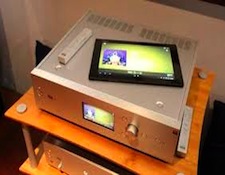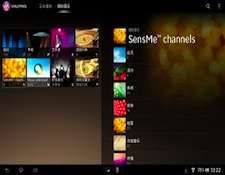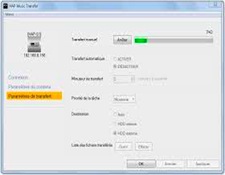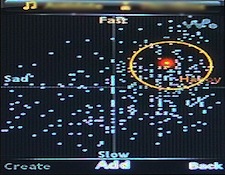It’s the time of year for saving money!
Two months ago I reviewed the Sony HAP-Z1ES music player for The Absolute Sound. Since then I’ve had more time to use some of its more idiosyncratic features. Most have proven to be more useful than I thought they would.
 Initially I was not exactly bowled over by Sony’s advanced shuffle feature – the twelve SenseMe™ “channels.” The twelve categories – morning, daytime, evening, midnight, energetic, relax, upbeat, mellow, lounge, emotional, dance, and extreme; work, according to Wikipedia, “by mapping music to a dual axis map based on the mood and tempo of music tracks. Mood and tempo are determined by using the appropriate Sony compatible software, which analyzes music tracks individually and computes the relevant track information. Analyzed tracks can then be plotted onto an intuitive dual axis map through which the music library on the device can be navigated…The horizontal axis is based on mood and the vertical axis is based on tempo.”
Initially I was not exactly bowled over by Sony’s advanced shuffle feature – the twelve SenseMe™ “channels.” The twelve categories – morning, daytime, evening, midnight, energetic, relax, upbeat, mellow, lounge, emotional, dance, and extreme; work, according to Wikipedia, “by mapping music to a dual axis map based on the mood and tempo of music tracks. Mood and tempo are determined by using the appropriate Sony compatible software, which analyzes music tracks individually and computes the relevant track information. Analyzed tracks can then be plotted onto an intuitive dual axis map through which the music library on the device can be navigated…The horizontal axis is based on mood and the vertical axis is based on tempo.”
 SenseMe™ was first introduced by Sony in 2009, and has been available on Sony’s PlayStation 3 and many Sony handsets since 2010. Its implementation on the Sony HAP-Z1ES was my first exposure, and at first I was not impressed. But after a several months of use I’ve learned that in most situations the SenseMe™ “channels” can deliver a better user experience than ordinary “shuffle” settings, even those designated within a particular musical genre. The Sonos wireless players have a genre-designated shuffle feature, but it tends to be rather limited in scope and gravitates toward more often-played tracks. Since the speed and mood designators in SenseMe™ are cross-genre, I’ve heard a lot more interesting musical juxtapositions than with a single-genre shuffle systems. Also, it seems that SenseMe™ is a lot more adventurous in choosing less-played tracks than most shuffle programs (especially iTunes).
SenseMe™ was first introduced by Sony in 2009, and has been available on Sony’s PlayStation 3 and many Sony handsets since 2010. Its implementation on the Sony HAP-Z1ES was my first exposure, and at first I was not impressed. But after a several months of use I’ve learned that in most situations the SenseMe™ “channels” can deliver a better user experience than ordinary “shuffle” settings, even those designated within a particular musical genre. The Sonos wireless players have a genre-designated shuffle feature, but it tends to be rather limited in scope and gravitates toward more often-played tracks. Since the speed and mood designators in SenseMe™ are cross-genre, I’ve heard a lot more interesting musical juxtapositions than with a single-genre shuffle systems. Also, it seems that SenseMe™ is a lot more adventurous in choosing less-played tracks than most shuffle programs (especially iTunes).
 Another feature in the HAP-Z1ES that has continued to impress me is the HAP Music Transfer application. This program looks for new music in any designated music library and transfers it to the Sony HAP-Z1ES. If you have a large music library and an organized CD ripping method that you’ve been using for awhile, the HAP Music Transfer program is easy to incorporate into your system. Once a week I open the program and it moves new music that I’ve acquired during the week over to the HAP-Z1ES. I especially like the option within the program to specify which file formats you want to transfer. Since I don’t rip CDs to MP3 formats, I leave that format box unchecked, which speeds up the transfer process since the program doesn’t have to do any searches for MP3s.
Another feature in the HAP-Z1ES that has continued to impress me is the HAP Music Transfer application. This program looks for new music in any designated music library and transfers it to the Sony HAP-Z1ES. If you have a large music library and an organized CD ripping method that you’ve been using for awhile, the HAP Music Transfer program is easy to incorporate into your system. Once a week I open the program and it moves new music that I’ve acquired during the week over to the HAP-Z1ES. I especially like the option within the program to specify which file formats you want to transfer. Since I don’t rip CDs to MP3 formats, I leave that format box unchecked, which speeds up the transfer process since the program doesn’t have to do any searches for MP3s.
 Some “early considerers” (I can’t call them early adopters since they hadn’t really bought anything yet) complained adamantly about the fact that the Sony HAP-Z1ES doesn’t have its own CD reader/ripper built into it. They, unfortunately, miss the whole point of the HAP-Z1ES system – it’s designed for users who already have a music library and standardized ripping methodology. Instead of delivering a self-contained, closed, one-box digital music system, the HAP-Z1ES is designed to fit into established and existing digital music eco-systems. I happen to feel that this was a wise decision on Sony’s part. Perhaps they learned from watching Olive’s travails with a one-box closed system.
Some “early considerers” (I can’t call them early adopters since they hadn’t really bought anything yet) complained adamantly about the fact that the Sony HAP-Z1ES doesn’t have its own CD reader/ripper built into it. They, unfortunately, miss the whole point of the HAP-Z1ES system – it’s designed for users who already have a music library and standardized ripping methodology. Instead of delivering a self-contained, closed, one-box digital music system, the HAP-Z1ES is designed to fit into established and existing digital music eco-systems. I happen to feel that this was a wise decision on Sony’s part. Perhaps they learned from watching Olive’s travails with a one-box closed system.
Since its release two companies, so far, have decided to offer modifications for the Sony HAP-Z1ES. Both Red Wine Audio and Modwright are looking into modifications to the HAP-Z1ES analog section. Red Wine has developed modifications that replace the hard drive with a 1TB SS drive, change the output section to a tube-based circuit, and install a new power supply. Modwright is concentrating on replacing the analog section with a tube-based circuit and external power. As to whether these modifications will be cost-effective sonic upgrades with no downsides (besides voiding the FIVE YEAR Sony ES warranty) only time will tell…but I am a little surprised at the number of “early considerers” who want to send the HAPZ1-ES directly to a modifier before even hearing the stock version, especially since the modifications will effectively DOUBLE the price of their HAP-Z1ES.
While I would never discourage someone from developing potential improvements to stock units, I’m going to live with my HAP-Z1ES in its original form for quite a while before considering any modifications.
And living happily with the HAP-Z1ES is a very easy thing to do…





